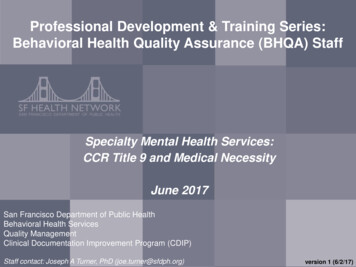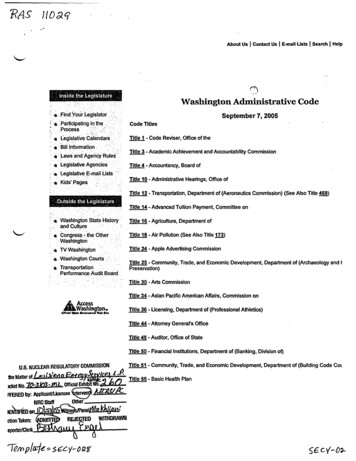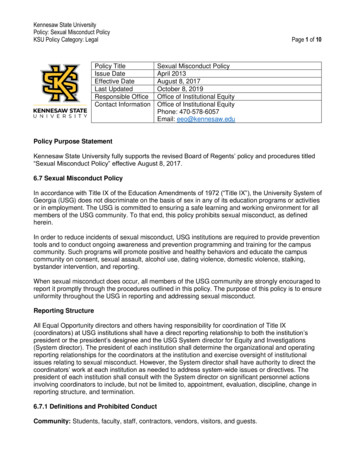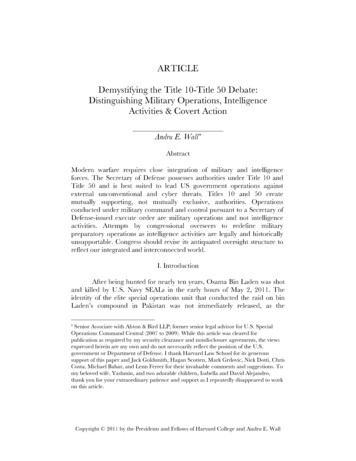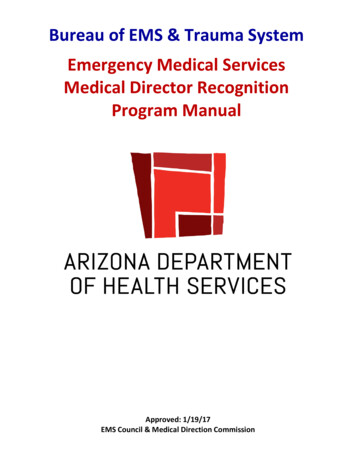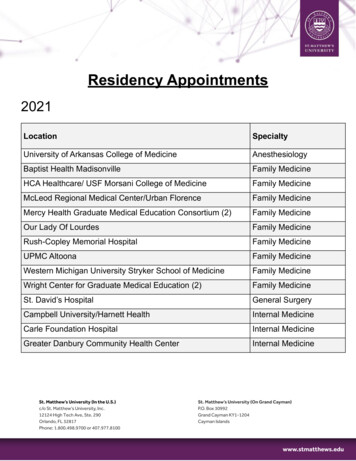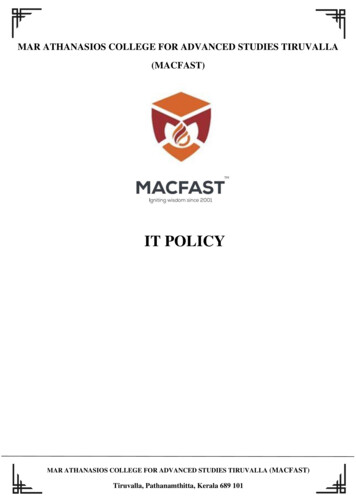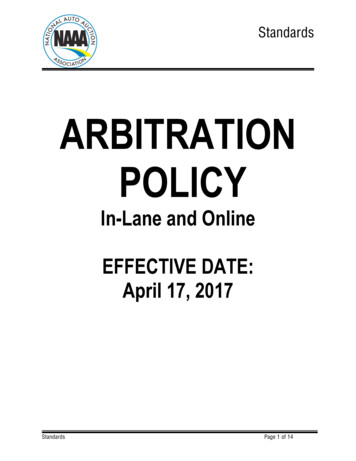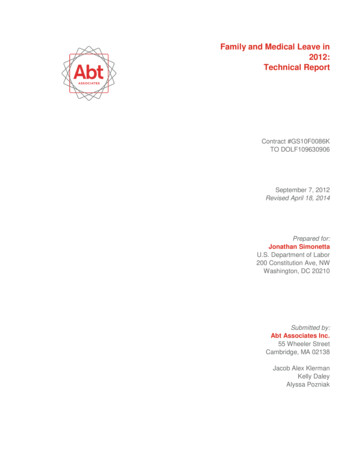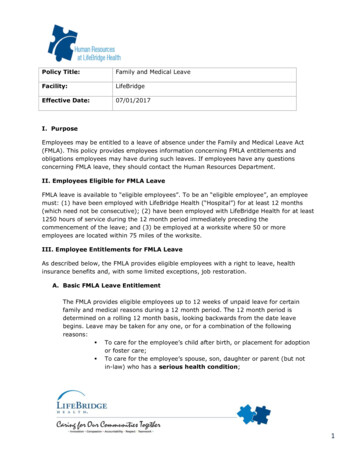
Transcription
Policy Title:Family and Medical LeaveFacility:LifeBridgeEffective Date:07/01/2017I. PurposeEmployees may be entitled to a leave of absence under the Family and Medical Leave Act(FMLA). This policy provides employees information concerning FMLA entitlements andobligations employees may have during such leaves. If employees have any questionsconcerning FMLA leave, they should contact the Human Resources Department.II. Employees Eligible for FMLA LeaveFMLA leave is available to “eligible employees”. To be an “eligible employee”, an employeemust: (1) have been employed with LifeBridge Health (“Hospital”) for at least 12 months(which need not be consecutive); (2) have been employed with LifeBridge Health for at least1250 hours of service during the 12 month period immediately preceding thecommencement of the leave; and (3) be employed at a worksite where 50 or moreemployees are located within 75 miles of the worksite.III. Employee Entitlements for FMLA LeaveAs described below, the FMLA provides eligible employees with a right to leave, healthinsurance benefits and, with some limited exceptions, job restoration.A. Basic FMLA Leave EntitlementThe FMLA provides eligible employees up to 12 weeks of unpaid leave for certainfamily and medical reasons during a 12 month period. The 12 month period isdetermined on a rolling 12 month basis, looking backwards from the date leavebegins. Leave may be taken for any one, or for a combination of the followingreasons: To care for the employee’s child after birth, or placement for adoptionor foster care; To care for the employee’s spouse, son, daughter or parent (but notin-law) who has a serious health condition;1
For the employees own serious health condition (including anyperiod of incapacity due to pregnancy, prenatal medical care orchildbirth) that makes the employee unable to perform one or more ofthe essential functions of the employee’s job; and/orBecause of any qualifying need arising out of the fact that anemployee’s spouse, son, daughter or parent is a military member oncovered active duty or call to covered active duty status (or has beennotified of an impending call or order to covered active duty) in theReserve component of the Armed Forces for deployment to a foreigncountry in support of a contingency operation or Regular Armed Forcesfor deployment to a foreign country.A serious health condition is an illness, injury, impairment, or physical or mentalcondition that involves either an overnight stay in a medical care facility, or continuoustreatment by a health care provider for a condition that either prevents the employee fromperforming the functions of the employee’s job, or prevents the qualifies family memberfrom participating in school or other daily activities. Subject to certain conditions, thecontinuing treatment requirement may be met by a period of incapacity of more than 3consecutive calendar days combined with at least two visits to a health care provider or onevisit and a regimen of continuing treatment, or incapacity due to pregnancy, or incapacitydue to a chronic condition. Other conditions may meet the definition of continuingtreatment.Qualifying needs may include attending certain military events, arranging foralternative childcare, addressing certain financial and legal arrangements, attending certaincounseling sessions, caring for the parents of the military member on covered active dutyand attending post-deployment reintegration briefings.Spouses who are both employed by LifeBridge Health and request leave due to thebirth or placement of a child or to care for the same family member may only take acombined total of 12 work weeks during any 12 month period. For other circumstances thatqualify under the Family and Medical Leave Act, spouses may not take more than 12 workweeks each of family and medical leave during any 12 month period.Eligible employees who work part-time (at least 1250 hours) and those who workvariable hours will have their family medical leave benefits calculated on a pro rata basis. Ifan employee’s work schedule varies from week to week, the average weekly hours worked2
during the 12 weeks prior to the start of the family and medical leave will be used tocalculate the employee’s FMLA leave entitlement.B.Leave)Additional Military Family Leave Entitlement (Injured Service memberIn addition to the basic FMLA leave entitlement discussed above, an eligible employee whois the spouse, son, daughter, parent or next of kin of a covered service member isentitled to take up to 26 weeks of leave during a single 12-month period to care for theservice member with a serious injury or illness. Leave to care for a service member shallonly be available during a single 12-month period and, when combined with other FMLAqualifying leave, may not exceed 26 weeks during the single 12-month period. The single12-month period begins on the first day an eligible employee takes leave to care for theinjured service member.A “covered service member” is a current member of the Armed Forces, including amember of the National Guard or Reserves, who is undergoing medical treatment,recuperation, or therapy, is otherwise in outpatient status, or is on the temporary retiredlist, for a serious injury or illness.These individuals are referred to in this policy as “current members of the Armed Forces.”Covered service members also include a veteran who is discharged or released from militaryservice under condition other than dishonorable at any time during the five (5) year periodprior to the first date the eligible employee takes FMLA leave to care for the coveredveteran, and who is undergoing medical treatment, recuperation or therapy for a seriousinjury or illness. These individuals are referred to in this policy as “covered veterans”.The FMLA definitions of a “serious injury or illness” for current Armed Forces members andcovered veterans are distinct from the FMLA definition of “serious health condition”applicable to FMLA leave to care for a covered family member.C.Intermittent Leave and Reduced Leave SchedulesFMLA leave usually will be taken for a period of consecutive days, weeks or months.However, employees also are entitled to take FMLA leave intermittently or on a reducedleave schedule when medically necessary due to a serious health condition of the employeeor covered family member or a serious injury or illness of a covered service member.Qualifying need leave also may be taken on an intermittent basis.3
D.Protection of Group Health Insurance BenefitsDuring FMLA leave, eligible employees are entitled to receive group health plan coverage onthe same terms and conditions as if they had continued to work.E.Restoration of Employment and BenefitsAt the end of FML A leave, subject to some exceptions including situations where jobrestoration of “key employees” will cause the LifeBridge Health substantial and grievouseconomic injury, employees generally have a right to return to the same or equivalentposition with equivalent pay, benefits and other employment terms. LifeBridge Health willnotify employees if they qualify as “key employees”, if it intends to deny reinstatement, andof their rights in such instances. Use of FMLA leave will not result in the loss of anyemployment benefit that accrued prior to the start of an eligible employee’s FMLA leave.F.Notice of Eligibility for, and Designation of, FMLA LeaveEmployees requesting FMLA leave are entitled to receive written notice from FMLA Sourcetelling them whether they are eligible for FMLA leave and, if not eligible, the reasons whythey are not eligible. When eligible for FMLA leave, employees are entitled to receive writtennotice of” 1) their rights and responsibilities in connection with such leave; 2)LifeBridgeHealth’s designation of leave as FMLA-qualifying or non-qualifying, if not FMLA-qualifying,the reasons why; and 3)the amount of leave, if known, that will be counted against theemployee’s leave entitlement.LifeBridge Health may retroactively designate leave as FMLA leave with appropriate writtennotice to employees provided Lifebridge Health’s failure to designate leave as FMLAqualifying at an earlier date did not cause harm or injury to the employee. In all caseswhere leaves qualify for FMLA protection, LifeBridge Health and the employee can mutuallyagree that leave be retroactively designated as FMLA leave.IV.Employee FMLA Leave ObligationsA.Provide Notice of the Need for LeaveEmployees who take FMLA leave must timely notify FMLA Source of their need for FMLAleave. The following describes the content and timing of such employee notices.4
B.Content of Employee NoticeTo trigger FMLA leave protections, employees must inform FMLA Source of the need forFMLA-qualifying leave and the anticipated timing and duration of the leave, if known.Employees may do this by either requesting FMLA leave specifically, or explaining thereasons for leave so as to allow FMLA Source to determine that the leave is FMLA-qualifying.For example, employees might explain that: A medical condition renders them unable to perform the functions of theirjob;They are pregnant and have been hospitalized overnight;They or a covered family member are under the continuing care of a healthcare provider;The leave is due to a qualifying need caused by a military member being oncovered active duty status to a foreign country; orIf the leave is for a family member, that the condition renders the familymember unable to perform daily activities or that the family member is acovered service member with a serious injury or illness.Calling in “sick” without providing the reasons for the needed leave, will not be consideredsufficient notice for FMLA leave under this policy. Employees must respond to LifebridgeHealth’s FMLA Source questions to determine if absences are potentially FMLA-qualifying.If employees fail to explain the reasons for the FMLA leave, the leave may be denied. Whenemployees seek leave due to FMLA-qualifying reasons for which LifeBridge Health haspreviously provided FMLA-protected leave, they must specifically reference the qualifyingreason for the leave or the need for the FMLA leave.C.Timing of Employee NoticeWhen an employee is absent for three (3) or more consecutive days, Human Resourcesand/or FMLA Source must be notified.Employees must provide 30 days advance notice of the need to take FMLA leave when theneed is foreseeable. When 30 days’ notice is not possible, or the approximate timing of theneed for leave is not foreseeable, employees must provide LifeBridge Health and FMLASource notice of the need for leave as soon as practicable under the facts andcircumstances of the particular case. Employees who fail to give 30 days’ notice for5
foreseeable leave without a reasonable excuse for the delay, or otherwise fail to satisfyFMLA notice obligations, may have FMLA leave delayed or denied.D.Cooperate in the Scheduling of Planned Medical Treatment (IncludingAccepting Transfers To alternative Positions) and Intermittent Leave orReduced Leave Schedules.Employees must consult with LifeBridge Health prior to the scheduling of treatment to workout a treatment schedule which best suits the needs of both LifeBridge Health and theemployees, subject to the approval of an employee’s health care provider. If employee isproviding notice of the need to take FML leave on an intermittent basis for planned medicaltreatment neglect to fulfill this obligation, LifeBridge Health may require employees toattempt to make such arrangements, subject to the approval of the employee’s health careprovider.When employees take intermittent or reduced work schedule leave for foreseeable plannedmedical treatment for the employees or a family member, including during a period ofrecovery from a serious health condition or to care for a covered service member, LifebridgeHealth may temporarily transfer employees, during the period that the intermittent leave orreduced leave schedules are required, to alternative positions with equivalent pay andbenefits for which the employees are qualified and which better accommodate recurringperiods of leave.When employees seek intermittent leave or a reduced leave schedule for reasons unrelatedto the planning of medical treatment, upon request, employees must advise FMLA Source ofthe reason why such leave is medically necessary. In such instances, LifeBridge Health andthe employee shall attempt to work out a leave schedule that meets the employee’s needswithout unduly disrupting LifeBridge Health’s operations, subject to the approval of theemployee’s health care provider.E.Submit Medical Certifications Supporting Need for FMLA Leave(Unrelated to Requests for Military Family Leave)Depending on the nature of FMLA leave sought, employees may be required to submitmedical certifications supporting their need for FMLA-qualifying leave. As described below,there generally are three types of FMLA medical certifications: an initial certification, arecertification, and a return to work/fitness for duty certification.6
It is the employee’s responsibility to provide FMLA Source with timely, complete andsufficient medical certifications. Whenever FMLA Source requests employees to provide MLAmedical certifications, employees must provide the requested certifications within 15calendar days after the request, unless it is not practicable to do so despite an employee’sdiligent, good faith efforts. FMLA Source will inform employees if submitted medicalcertifications are incomplete or insufficient and provide employees at least seven calendardays to cure deficiencies. FMLA Source will deny FMLA leave to employees who fail to timelycure deficiencies or otherwise fail to timely submit requested medical certifications.With the employee’s permission, FMLA Source may contact the employee’s health careprovider to authenticate or clarify completed and sufficient medical certifications. Ifemployees choose not to provide FMLA Source with authorization allowing it to clarify orauthenticate certifications with health care providers, FMLA Source may deny FMLA leave ifcertifications are unclear.Whenever LifeBridge Health deems it appropriate to do so, it may waive its right to receivetimely, compete and/or sufficient FMLA medical certifications.F.Initial Medical CertificationsAssociates requesting leave because of their own, or a covered relation’s, serious healthcondition, or to care for a covered service member, must supply medical certificationsupporting the need for such leave from their health care provider or, if applicable, thehealth care provider of their covered family or service member. If employees provide atleast 30 days’ notice of medical leave, they should submit the medical certification beforeleave begins. A new initial medical certification will be required on an annual basis forserious medical conditions lasting beyond a single leave year.If the hospital or FMLA Source has reason to doubt initial medical certifications, it mayrequire employees to obtain a second opinion at the hospital’s expense. If the opinions ofthe initial and second health care providers differ, the hospital may, at its expense, requireemployees to obtain a third, final and binding certification from a health care providerdesignated or approved jointly by the hospital and the employee.G.Medical RecertificationDepending on the circumstances and duration of FMLA leave, the hospital or FMLA Sourcemay require employees to provide recertification of medical conditions giving rise to theneed for leave. The hospital or FMLA source will notify employees if recertification is7
required and will give employees at least 15 calendar days to provide medicalrecertification.H.Return to Work/Fitness for Duty CertificationsEmployees returning to work from FMLA leaves that were taken because of their ownserious health conditions that made them unable to perform their jobs must provide thehospital medical certification confirming they are able to return to work and the employees’ability to perform the essential functions of the employees’ position, with or withoutreasonable accommodation. The hospital may delay and/or deny job restoration until theemployees provide return to work/fitness for duty certifications.I.Submit Certifications Supporting Need for Military Family LeaveUpon request, the first time employees seek leave due to qualifying need arising out of thecovered active duty or call to covered active duty status of a military member, the hospitalmay require employees to provide: 1)a copy of the military member’s active duty orders orother documentation issued by the military indicating the military member is covered activeduty or call to active duty status and the dates of the military members’ covered active dutyservice; and 2) a certification from the employee setting forth information concerning thenature of the qualifying need for which leave is requested. Employees shall provide a copyof new active duty orders or other documentation issued by the military for leaves arisingout of qualifying need arising out of a different covered active duty or call to covered activeduty status of the same or a different military member.When leave is taken for a covered service member with a serious injury or illness, FMLASource may require employees to obtain certifications completed by an authorized healthcare provider of the covered service member. In addition, and in accordance with the FMLAregulations, FMLA Source may request that the certification submitted by employees setadditional information provided by the employee and/or the covered service memberconfirming entitlement to such leave.J.Substitute Paid Leave for Unpaid FMLA LeaveSinai employees must use any accrued Sick and Safe Leave, Paid Time Off (PTO) and anyExtended Illness Bank (EIB) benefits as the first part of any FMLA leave; howeveremployees may hold up to 40 hours of Paid Time Off (PTO), if available. Employees ofNorthwest Hospital and Levindale Geriatric Center and Hospital, who accrue vacation, sickand safe leave, sick leave, personal and holidays hours, must first exhaust sick and safe8
leave, sick leave, then personal, holiday and vacation hours in that order. However,employees of Northwest Hospital and Levindale Geriatric Center and Hospital may also electto hold up to 40 hours of vacation if available. The substitution of paid time for unpaid FMLAleave time does not extend the length of FMLA leaves and the paid time will runconcurrently with an employee’s FMLA entitlement.Sinai employees using available PTO hours are on paid leave and eligible for benefitaccruals. When an employee is on unpaid family medical leave, PTO accruals will cease.For employees of Northwest Hospital and Levindale Geriatric Center and Hospital, benefitaccruals on based on hours worked. Therefore, for employees of Northwest Hospital andLevindale Geriatric Center and Hospital, benefit accruals will cease while on FMLA Leave.Leaves of absence taken in connection with a disability leave plan or workers’ compensationinjury/illness shall run concurrently with any FMLA leave entitlement.K.Pay Employee’s Share of Health Insurance PremiumsAs noted above, during FMLA leave, employees are entitled to continue group health plancoverage under the same conditions as if they had continued to work. Unless the hospitalnotifies employees of other arrangements, whenever employees are receiving pay from thehospital during FMLA leave, the hospital will deduct the employee portion of the grouphealth plan premium from the employee’s paycheck in the same manner as if the employeewas actively working. If FMLA leave is unpaid, the employee is responsible for paying thenormal payroll deduction amount for health insurance benefits directly to Human Resourcesfor the remainder of the leave. If the employee is more than 30 days late paying therequired health insurance cost, the hospital may drop the employee from all healthinsurance coverage. If the employee’s payment is more than 15 days late, the hospital willsend a letter notifying the employee that coverage will be dropped on a specific date unlessco-payment is received before the due date. If employees do not return to work within 30calendar days at the end of the leave period (unless employees cannot return to workbecause of a serious health condition or other circumstances beyond their control) they willbe required to reimburse the hospital for the cost of the premiums the hospital paid formaintaining coverage during their unpaid FMLA leave.L.Limitations While on a Consecutive Leave of AbsenceEmployees on a consecutive day FMLA leave of absence (not intermittent leave) are notpermitted to attend meetings, access hospital e-mail or voice mail or work in any capacity.9
An employee who must attend a non-job related activity (e.g. staff meeting or mandatoryeducation), must have a physician release for the specific activity.M.Report Periodically Concerning Intent to Return to WorkEmployees must contact the hospital periodically regarding their status and intention toreturn to work at the end of the FMLA leave period. If an employee’s anticipated return towork date changes and it becomes necessary for the employee to take more or less leavethan originally anticipated, the employee must provide the hospital and FMLA Source withreasonable notice (i.e., within 2 business days) of the employee’s changed circumstancesand new return to work date. If employees give the hospital unequivocal notice of theirintent not to return to work, the hospital’s obligation to maintain health benefits (subject toCOBRA requirements) and to restore their positions cease.N.Shared FMLA LeaveWhen spouses work for Lifebridge Health and each spouse is eligible to take FMLA leave, theFMLA limits the combined amount of leave they may take for some, but not all, FMLAqualifying leave reasons. For the purposes of FMLA leave, spouse means a husband or wifeas defined or recognized by the state of Maryland and includes individuals in same sexmarriages.Eligible spouses who work for LifeBridge Health are limited to a combined total of 12workweeks of leave in a 12-month period for the following FMLA qualifying reasons: The birth of a son or daughter and bonding with the newborn child, The placement of a son or daughter with the employee for adoption or fostercare and bonding with the newly-placed child, and The care of a parent with a serious health conditionEligible spouses are also limited to a combined 26 workweeks of leave in a single 12-monthperiod to care for a covered service member with a serious injury or illness (commonlyreferred to as "military caregiver leave") if each spouse is a parent, spouse, son ordaughter, or next of kin of the service member. When spouses take military caregiver leaveas well as other FMLA leave in the same leave year, each spouse is subject to the combinedlimitations for the reasons for leave listed above.10
V.Coordination of FMLA Leave with Other Leave PoliciesThe FMLA does not affect federal, state or local law prohibiting discrimination, or supersedeany State or local law which provides greater family or medical leave rights. For additionalinformation concerning leave entitlements and obligations that might arise when FMLA leaveis either not available or exhausted, please consult the hospital’s other leave policies orcontact Human Resources.VI.Questions and/or Complaints about FMLA LeaveIf you have questions regarding this FMLA policy, please contact Human Resources or FMLASource. The hospital and FMLA Source are committed to complying with the FMLA and,whenever necessary, shall interpret and apply this policy in a manner consistent with theFMLA.The FMLA makes it unlawful for employers to: 1)interfere with, restrain, or deny theexercise of any right provided under the FMLA; or 2) discharge or discriminate against anyperson for opposing any practice made unlawful by FMLA or involvement in any proceedingunder or relating to FMLA. If employees believe their FMLA rights have been violated, theyshould contact the Human Resources department immediately. The hospital will investigateany FMLA complaints and take [prompt and appropriate remedial action to address and/orremedy any FMLA violation. Employees also may file FMLA complaints with the UnitedStates Department of Labor or may bring private lawsuits alleging FMLA violations.VII.Additional Definitions:“Spouse” means a husband or wife as defined or recognized under State law for purposesof marriage in the State where the employee resides, including common law marriage inStates where it is recognized. Spouse does not include an unmarried domestic partner.“Parent” means a biological, adoptive, step or foster father or mother, or any otherindividual who stood in loco parentis to the employee when the employee was a son ordaughter as defined in paragraph (c) of this section. This term does not include parents “inlaw”.“Son or daughter” means, for the purposes of FMLA leave taken for birth or adoption, orto care for a family member with a serious health condition, a biological, adopted, or fosterchild, a stepchild, a legal ward, or a child of a person standing in loco parentis, who is eitherunder age 18, or age 18 or older and “incapable of self-care because of a mental or physical11
disability” at the time that FMLA leave is to commence. The age when the disability occurs isirrelevant to determine whether an adult son or daughter has a mental or physical disability.“Incapable of self-care” means that the individual requires active assistance orsupervision to provide daily self-care in three or more of the “activities of daily living”(ADLs) or “instrumental activities of daily living” (IADLs). Activities of daily living includeadaptive activities such as caring appropriately for one’s grooming and hygiene, bathing,dressing and eating. Instrumental activities of daily living include cooking, cleaning,shopping, taking public transportation, paying bills, maintaining a residence, usingtelephones and directories, using a post office, etc.“Physical or mental disability” means a physical or mental impairment that substantiallylimits one or more of the life activities of an individual. Regulations at 29 CFR 1630.2(h), (i),and (j), issued by the Equal Employment Opportunity Commission under the Americans withDisabilities Act (ADA), 42 U.S.C. 1201 et seq., define these terms.Persons who are “in loco parentis” include those with day-to-day responsibilities to carefor and financially support a child, or, in the case of an employee, who had suchresponsibility for the employee when the employee was a child. A biological or legalrelationship is not necessary.“Adoption” means legally and permanently assuming the responsibility of raising a child asone’s own. The source of an adopted child (e.g., whether from a licensed placement agencyor otherwise) is not a factor in determining eligibility for FMLA leave.“Foster Care” is 24-hour care for children in substitution for, and away from, their parentsor guardian. Such placement is made by or with the agreement of the State as a result of avoluntary agreement between the parent or guardian that the child be removed from thehome, or pursuant to a judiciary determination of the necessity for foster care, and involvesagreement between the State and foster family that the foster family will take care of thechild. Although foster care may be with relatives of the child, State action is involved in theremoval of the child from parental custody.“Son or daughter on covered active duty or call to covered active duty status”means the employee’s biological, adopted, or foster child, stepchild, legal ward, or a childfor whom the employee stood in locos parentis, who is on covered active duty or call tocovered active duty status, and who is of any age.12
“Son or daughter of a covered service member” means the covered service member’sbiological, adopted, or foster child, stepchild, legal ward, or a child for whom the employeestood in loco parentis, who is on covered active duty or call to covered active duty status,and who is of any age.“Serious injury or illness” means:(1) In case of a current member of the Armed Forces, including a member of theNational Guard or Reserves, means an injury or illness that was incurred by thecovered service member in the line of duty on active duty in the Armed Forces orthat existed before the beginning of the member’s active duty and was aggravatedby service in the line of duty on active duty in the Armed Forces, and that mayrender the member medically unfit to perform the duties of the member’s office,grade, rank or rating; and(2) In that case of a covered veteran, means an injury or illness that was incurred by themember in the line of duty on active duty in the Armed Forces (or existed before thebeginning of the member’s active duty and was aggravated by service in the line ofduty on active duty in the Armed Forces) and manifested itself before or after themember became a veteran, and is:(i) a continuation of a serious injury or illness that was incurred or aggravated when thecovered veteran was a member of the armed Forces and rendered the servicemember unable to perform the duties of the service member’s office, grade,rank, or rating; or(ii) a physical or mental condition for which the covered veteran has received a U.S.Department of Veterans Affairs Service-Related Disability Rating (VASRD) of 50percent or greater, and such VASRD rating is based, in whole or in part, on thecondition precipitating the need for military caregiver leave; or(iii) a physical or mental condition that substantially impairs the covered veteran’s abilityto secure or follow a substantially gainful occupation by reason of a disability ordisabilities related to military service, or would do so absent treatment; or(iv)an injury, including a psychological injury, on the basis of which the covered veteranhas
If an employee's anticipated return to work date changes and it becomes necessary for the employee to take more or less leave than originally anticipated, the employee must provide the hospital and FMLA Source with reasonable notice (i.e., within 2 business days) of the employee's changed circumstances and new return to work date.
